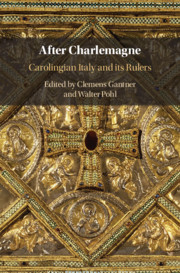Book contents
- After Charlemagne
- After Charlemagne
- Copyright page
- Contents
- Contributors
- Additional material
- 1 Italy after Charlemagne
- 2 A Brief Introduction to Italian Political History until 875
- Section I Was There a Carolingian Italy?
- Section II Organizing Italy
- 6 The Government of a Peripheral Area
- 7 Vassals without Feudalism in Carolingian Italy
- 8 Shaping a Kingdom
- Section III Carolingian Rulers
- Section IV Cities, Courts and Carolingians
- Bibliography
- Index
7 - Vassals without Feudalism in Carolingian Italy
from Section II - Organizing Italy
Published online by Cambridge University Press: 03 December 2020
- After Charlemagne
- After Charlemagne
- Copyright page
- Contents
- Contributors
- Additional material
- 1 Italy after Charlemagne
- 2 A Brief Introduction to Italian Political History until 875
- Section I Was There a Carolingian Italy?
- Section II Organizing Italy
- 6 The Government of a Peripheral Area
- 7 Vassals without Feudalism in Carolingian Italy
- 8 Shaping a Kingdom
- Section III Carolingian Rulers
- Section IV Cities, Courts and Carolingians
- Bibliography
- Index
Summary
How does one study the Carolingian vassals after the renewal of historiographic paradigms following the publication of Susan Reynolds' Fiefs and Vassalls? In this chapter, I tried to answer this question. It focusses on the reconstruction of the meaning given to the term vassus in the so-called Italic capitularies; the latter, although they certainly cannot be considered a homogenous genre, do, nevertheless, share a specific and coherent political vocabulary. Carolingian vassalage–whether Italian or not – is thus clearly far from being a ‘conceptual black hole’, but nor was it merely a bulwark against the dissolution of the state, as hypothesized by Ganshof. Vassalage was, in fact, a very flexible instrument, which could be adopted by the government in newly conquered territories in relation to ‘agents’ who supported the king/emperor, the counts and the bishops in their functions. It could also be adopted by individual ‘magnates’ for services related to their own domus. Therefore in Italy, as elsewhere, two models of vassalages emerged. This flexibility was the reason for the success of vassalage in Carolingian Italy.
Keywords
- Type
- Chapter
- Information
- After CharlemagneCarolingian Italy and its Rulers, pp. 94 - 115Publisher: Cambridge University PressPrint publication year: 2020

